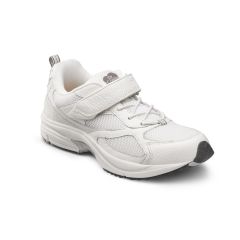
Heel Calluses
Heel calluses are thickened skin tissue, usually caused by repetitive, excessive friction. They’re your skin’s attempt to protect itself. The problem with this phenomenon is that the extra tissue produces more friction, worsening the condition — until it actually becomes painful.
Diabetes often causes calluses due to the changes in skin tissues and lack of sensation caused by nerve damage. Normally, a callus will begin to hurt with continued walking, to the point that you’ll seek medical attention. But if you cannot feel the pain and continue to put weight on a callus, the tissue will ulcerate. If you notice any signs of redness or blistering in your callus, contact a podiatrist.
Other medical conditions that cause calluses include psoriasis, warts, and some skin infections and skin disorders.
How Footwear Can Help
The best treatment is to reduce friction and pressure on the callused area with appropriate footwear. Adding an insert or orthotic will help restrict the motion of the foot and reduce unwanted stress on your heel. Certain inserts may work better than others.
You can also try to reduce the thickness of a callus with a pumice stone followed by an application of a skin softening lotion. A podiatrist has specialized instruments to reduce the callus and can do a thorough exam of your biomechanics to get a better idea of what’s causing your calluses, then recommend a shoe and insert that will work best for you.
Adding an insert or orthotic will help restrict the motion of the foot and reduce unwanted stress on your heel.
We Recommend
-
View Details


Winner Plus
Men’s Athletic ShoeSpecial Price $123.75 Regular Price $165.0025% Off Save $41.25Rating:100%(14) Reviews>Lace-up cross-trainer with full top-grain leather and arch stabilization. -
View Details


Winner
Men’s Athletic ShoeSpecial Price $123.75 Regular Price $165.0025% Off Save $41.25Rating:86%(14) Reviews>Full top-grain leather trainer with arch stabilizer for improved support. -
View Details


Performance
Men’s Athletic ShoeSpecial Price $123.75 Regular Price $165.0025% Off Save $41.25Rating:85%(64) Reviews>Lightweight, cross-trainer providing arch stability, support and comfort. -
View Details


Endurance
Men’s Athletic ShoeSpecial Price $123.75 Regular Price $165.0025% Off Save $41.25Rating:89%(9) Reviews>Modern sneaker with no-tie elastic and soft leather for excellent comfort when moving.
-
View Details


Spirit
Women’s Athletic ShoeSpecial Price $123.75 Regular Price $165.0025% Off Save $41.25Rating:84%(5) Reviews>A versatile athletic shoe for women that’s lightweight, comfortable and chic. -
View Details


Victory
Women’s Athletic ShoeSpecial Price $123.75 Regular Price $165.0025% Off Save $41.25Rating:88%(10) Reviews>A Lightweight cross trainer with no-tie elastic laces for support and comfort during activities. -
View Details


Meghan
Women’s Athletic ShoeSpecial Price $49.50 Regular Price $165.0070% Off Save $115.50Rating:92%(12) Reviews>Stylish, seamless-designed sneaker with mesh uppers for all-day comfort. -
View Details


Katy
Women’s Athletic ShoeSpecial Price $49.50 Regular Price $165.0070% Off Save $115.50Rating:75%(21) Reviews>Stylish, lightweight athletic shoe with unique no-tie elastic lacing














